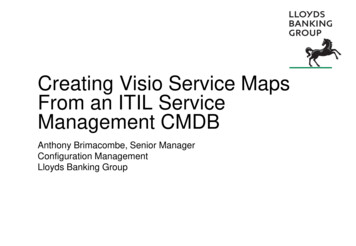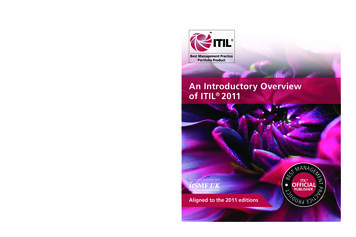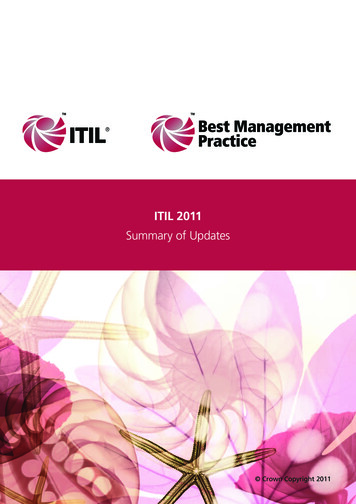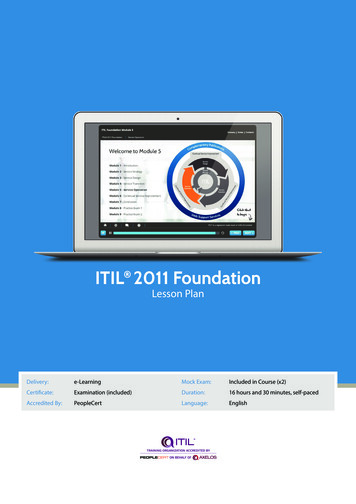
Transcription
13 ITIL Mind Maps: Service Management as a Practice ITIL Service Strategy ITIL Service Strategy Processes ITIL Service Design ITIL Service Design Processes ITIL Service Transition ITIL Service Transition (SACM) ITIL Service Transition (Change and Evaluation) ITIL Service Operation ITIL Service Operation Functions ITIL Service Operation Processes ITIL Continual Service Improvement ITIL CSI Improvement ProcessesITIL 2011 Mind MapsITIL is a registered trademark of the Cabinet Office. The Swirl Logo is a registered trademark of the Cabinet Office.
ITIL is a registered trademark of the Cabinet Office. This document can be shared internally.ITIL - Service Management as a PracticeFacilitates outcomes without costs & risksUncertainty of outcomeStandards - ISO20000RiskTraining and educationSourcesFunctionalityFitness for purposeIndustry practice - Sarbanes Oxley (SOX),Financial Services Authority (FSA)What the customer getsBestPracticeFitness for usePerformanceWarrantyInternal and external experienceResearchUtilityValue to customersHow service is deliveredServiceEmployeesCustomersEnablersEconomic valueSuppliersAdvisorsReputationShown byTechnologyCustomer PerceptionKnowledge to achieve business objectivesCoreEnablingClassificationCoordinated activitiesEnhancingPerformance drivenCreates value for customersMaintenanceDefines roles, activities, guidelinesProcessPrime customer contactMeasurableEnsures delivery meets requirementsServiceOwnerIdentify areas for input into CSIregister / raise RFC'sCommunication with Process OwnersReporting & monitoringAccountable for delivery of serviceCharacteristicsServiceManagementas a PracticeDefinitionsFunctionPerform certain types of workResponsibleAccountableAssists with designRACI ModelDocumentationInput to CSI registerSpecialised unitsResponsibility within process or functionDefines Strategy, policy, standardsCommunicationConsultedClarifies roles and responsibilitiesProcess Provides value for customers via servicesIT service managementServiceManagementOne personInformedProcessOwnerProcess practitionerSet of specialised capabilitiesCustomersResponds to triggersRoleAuditsSpecific icsImprovementRolesEnablersFor Online ITIL Training and Details of Special Offers - m
ITIL is a registered trademark of the Cabinet Office. This document can be shared internally.ITIL Service StrategyCurrent state assessmentAutomation canaffect performancetarget state definitionSimplify processesGap analysisTechnologyProject estimationProject consolidationRoadmapUnderstand flow ofactivitiesMinimise interactionsImplementationDefinition of rolesService portfolio, customer portfolio, customer agreement portfolioDemand management procedures, techniques and toolsDefine the market and identify customersUnderstand the customerDesigning the strategyQuantify the outcomesInterfaces between all service strategy processes and other processesEstablish and maintain business relationshipsEnsure service provider can meet needs of the businessClassify and visualise the serviceUnderstand the opportunitiesRules, policies, processes by whichbusinesses are operated, regulated,controlledDefine services based on outcomesService modelsAssists business in articulating value of serviceCore Services - deliver basic outcomesEvaluates, direc ts, monitors the strategy, policies and bling services are needed in order fora core service to be deliveredEnhancing services are excitement factorsDefine serviceunits andpackagesMonitorEstablish responsibilitiesDeliver the basic outcomes desired by the customerRepresent the value the customer wantsSupporting ServicesStrategy to set and meet objectivesEither enable or enhance the value propositionAcquire for valid reasonsFrameworkEnsure performance when requiredGovernancePackaging core and supporting servicesis an essential aspect of market strategyEnsure conformance with rulesPackaging will also have an impact on thedesign and operation of a serviceEnsure respect for human factorsService through collaborationStrategic AssetService through coordinationServices through delegationService ManagementStagesFinancesServices through directionInfrastructureServices through networkResourcesApplicationsPeopleWhat is our business?Who is our customer?What does the customer value?ServiceStrategyMarketing mind setWho depends on our services?AssetsHow do they use our ser vices?InformationService nowledgeWhy are they valuable to them?PeopleInternal (Type I)Future vs PresentShared Service Unit (SSU) (Type II)OpposingdynamicsExternal (Type III)Supplies service to one or more customersOutsourcingInsourcingService providerDisaggregationOperational effectiveness vsimprovements in functionalityValue capturePerspectiveAggregationPositionsDefined by customers4 P'sAffordable mix of featuresAchievement of objectivesChanges over time and circumstanceBusiness outcome achievedCustomer's preferencesPatternsValueOngoing ActionsValue for customerBenefitsBasic FactorsPerformance FactorsBusiness PortrayalHow to achieve visionCost effectivenessCreating valueCustomer's perception of what was deliveredExcitement FactorsPlansVisionKano modelFor Online ITIL Training and Details of Special Offers - Visit:Standardised processesServices create valueRespond quickly tochanges in businessenvironmentwww.itiltrainingzone.com
ITIL is a registered trademark of the Cabinet Office. This document can be shared internally.ITIL Service Strategy ProcessesHow a service provider will enable anorganization to achieve its businessoutcomesAnalyse internal and external factorsService DesignDevelopmentOperational ServicesService CatalogueDefine market spacesAssessmentService PipelineIdentify strategic industry factorsContentsEstablish objectivesDetermine perspectiveRetired ServicesStrategyManagementfor ITServicesTracks investment through lifecycle and ensuresappropriate returns are achievedEnsures services clearly defined andlinked to business outcomesWhy should they buy these services from us?Adopt patterns of actionAlign assets with outcomesOptimise CSFsExecutionPrioritise investmentsMeasurement and evaluationClarify the answers to keystrategic questionsWhat are our pricing and chargeback models?Craft a planProcessPurposeWhy should a customer buy these services?Form a positionGenerationTo ensure service provider has the right mix of services tobalance the investment in IT with ability to meet businessoutcomesCSIExpansion and growthAnnual planning cyclesWhat are our strengths, weaknesses, priorities and risks?New business opportunityTriggersHow should our resources and capabilities be allocated?Strategy managementChanges to internal and externalenvironmentsMergers or acquisitionsBusiness relationship managementProcess initiationCSIOther service management processesEnhanced decision makingStrategySpeed of changeRequest from businessValue to the businessService improvement opportunitiesService suggestionExisting servicesFinance compliance and controlOperational controlDefineValue capture and creationService, customer and business outcomesPortfolioManagementService modelsImpact on service portfolio and service modelCost centreProfit centreService portfolio reviewAnalyse investments, value and prioritiesSPMAnalysePolicy decisionsProcessFundingExternalInternalRolling planArticulate value propositionFunding modelsRetainRationaliseRefactorRenewApproveZero basedTrigger basedServiceStrategyProcessesReplaceService valuationService Investment AnalysisAssesses the value or return of a service over the total lifecycleBased on the value received and the costs incurredComplianceRetireOutputsChange proposalCost optimisationSeeks to translate outage severity into a financial valueChange management authorisationChange proposal authorisedBusiness Impact Assessment (BIA)FinancialmanagementCommunicate with stakeholdersService design and transition processesCharterAid to decision making and prioritisationHelps to identifyCost of service outageRelative value of servicesPlanning confidenceTrack progress and update portfolioAnalysis of previous budgetOpportunityAssessment of plansValue propositionBudgetingBusiness outcomes supportedPrioritiesBudget(s)Portfolio ContentsCost modelRisksCost centres and cost unitsOfferings & packagesCost types and elementsInvestments requiredAccountingCost & pricingScopeAnalyse patterns of business activityAnalysis and reportingAction plansObjectiveCost recovery or break evenDemandManagementWork with capacity managementAchieve balance between cost and value of outcomesRefines understanding of interactionsCost classificationChart of accountsTo identify and analyse the patterns of business activity thatinitiate demand for servicesUser ProfilesSpecification of changes to funding and spendingCost and income estimationBusiness casesPoliciesDecide on chargeable itemsEnable executives to evaluate real investmentPricingBillingService providerContractEstablish and maintain business relationshipsEnsure service provider can meet needs of the businessAssists business in articulating value of serviceObjectiveCross subsidisationNotional chargingChargingValue to businessRecovery with marginBusiness RelationshipManagementFor Online ITIL Training and Details of Special Offers - zone.com
ITIL is a registered trademark of the Cabinet Office. This document can be shared internally.ITIL Service DesignStatement of requirements (SOR)Identify business needInvitation to tender (ITT)Business casePeopleAward contractNegotiateEvaluation and procurement of new contracts and suppliers4 P'sSelect supplierSupplier and contractcategorisationMaintains supplier and contract management informationsystem (SCMIS)Value for moneySupplierManagementService solutionsWhy should a customer buythese services?Design IT services,together with thegoverning IT practices,processes and policies,to realize the serviceprovider’s strategy andto facilitate theintroduction of theseservices into supportedenvironments ensuringquality service delivery,customer satisfactionand cost-effectiveservice provision.Manage supplier and contractperformanceDefine and maintain policiesand methodsPlan design resources andcapabilitiesCoordinate design activitiesImprove service designPartnersProcessesEnsure contracts are aligned to businessManage design risks and issuesProductsDesign coordinationPlan, coordinate and monitorindividual designsReview designs and ensurehandover of SDPsWhy should they buy theseservices from us?What are the pricing orchargeback models?What are our strengths andweaknesses, priorities and risks?How should our resources andcapabilities be allocated?OpportunityService portfolioValue propositionBusiness outcomessupportedBusiness casesContentsSystems and toolsRisksOfferings and packagesCorporate visions, strategies, etcInvestments requiredService management visions, strategies,policies, objectives and plansOngoing costsand pricingConstraints and requirements for compliancewith standards and regulationsKey PrinciplesIT strategies, policies and plansBusiness requirementsPrioritiesInputsServices5 major aspectsSupported levels of performancePoliciesService portfolioMinimum requirementsITSM processes, risks and issues registersOrdering and requestService catalogueRevisions to IT strategies, policies, designs, plans,architectures, processesSupport terms and conditionsDependenciesService level packagePoints of contactServiceDesignReduced total cost of ownership (TCO)Improved quality of serviceConsistency of servicePricing and chargingBusiness / organisationEnterpriseEasier implementation of new servicesServiceTechnology and managementarchitecturesBetter service alignmentImprove service performanceImprove IT governanceBenefitsApplicationData / InformationEnvironmentImproved service alignmentIT InfrastructureMore effective servicemanagementDesign top down, build bottom upProcesses requiredBetter IT processesProgressImproved information and decision makingMeasurement methods and metricsCoordinate all design activitiesFunctionalityBalanced designProduce associated service design packagesEnsure service designs and/or SDPs are produced and handedover to service transitionEnsure all service models and service solution designs conform tostrategic, architectural, governance and other corporate requirementsImprove the effectiveness and efficiency of service design activities and processesEnsure that all parties adopt a common framework of standard, reusabledesign practicesEffectivenessEfficiencyPlan and coordinate the resources and capabilities required to designnew or changed servicesManage the quality criteria, requirements and handover between design,strategy and sAvailabilityOther Service DesignProcessesSee "Service Design Processes" MapMonitor and improve the performance of the service design lifecycle stageFor Online ITIL Training and Details of Special Offers - Visit: www.itiltrainingzone.comCapacityService LevelService Catalogue
ITIL is a reg istered trademark of the Cabinet Office. This document can be shared internally.ITIL Service Design ProcessesAlign IT security with business securityEffectively manage information securityManagement of risksManage information contained in service catalogueTraining & awarenessEnsure service catalogue is available and accurateSecurity strategy and planService CatalogueManagementManagement of suppliers and contracts regarding access to systems and servicesManagement of all security breaches and incidents associated with all systems and servicesProactive improvement of security controls, and security risk management and the reduction of security risksControlPlanLive servicesBusiness service catalogueIntegration of security
13 ITIL Mind Maps: Service Management as a Practice ITIL Service Strategy ITIL Service Strategy Processes ITIL Service Design ITIL Service Design Processes ITIL Service Transition ITIL Service Transition (SACM) ITIL Service Transition (Change and Evaluation) ITIL Service Operation ITIL Service Operation Functions ITIL Service Operation Processes










